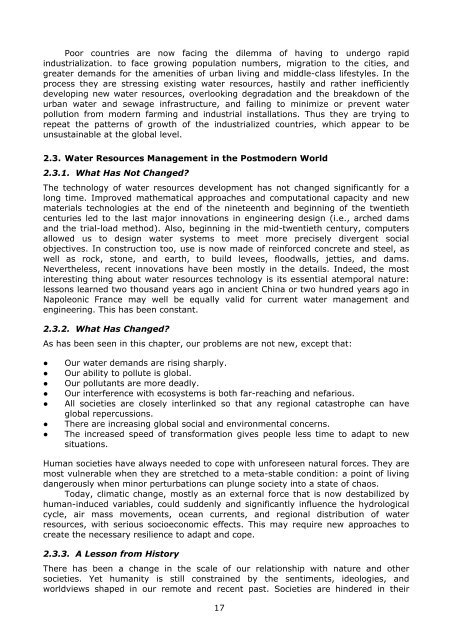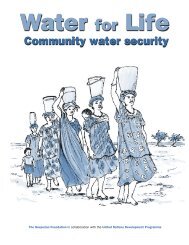Water security and peace: a synthesis of studies ... - unesdoc - Unesco
Water security and peace: a synthesis of studies ... - unesdoc - Unesco
Water security and peace: a synthesis of studies ... - unesdoc - Unesco
You also want an ePaper? Increase the reach of your titles
YUMPU automatically turns print PDFs into web optimized ePapers that Google loves.
Poor countries are now facing the dilemma <strong>of</strong> having to undergo rapid<br />
industrialization. to face growing population numbers, migration to the cities, <strong>and</strong><br />
greater dem<strong>and</strong>s for the amenities <strong>of</strong> urban living <strong>and</strong> middle-class lifestyles. In the<br />
process they are stressing existing water resources, hastily <strong>and</strong> rather inefficiently<br />
developing new water resources, overlooking degradation <strong>and</strong> the breakdown <strong>of</strong> the<br />
urban water <strong>and</strong> sewage infrastructure, <strong>and</strong> failing to minimize or prevent water<br />
pollution from modern farming <strong>and</strong> industrial installations. Thus they are trying to<br />
repeat the patterns <strong>of</strong> growth <strong>of</strong> the industrialized countries, which appear to be<br />
unsustainable at the global level.<br />
2.3. <strong>Water</strong> Resources Management in the Postmodern World<br />
2.3.1. What Has Not Changed?<br />
The technology <strong>of</strong> water resources development has not changed significantly for a<br />
long time. Improved mathematical approaches <strong>and</strong> computational capacity <strong>and</strong> new<br />
materials technologies at the end <strong>of</strong> the nineteenth <strong>and</strong> beginning <strong>of</strong> the twentieth<br />
centuries led to the last major innovations in engineering design (i.e., arched dams<br />
<strong>and</strong> the trial-load method). Also, beginning in the mid-twentieth century, computers<br />
allowed us to design water systems to meet more precisely divergent social<br />
objectives. In construction too, use is now made <strong>of</strong> reinforced concrete <strong>and</strong> steel, as<br />
well as rock, stone, <strong>and</strong> earth, to build levees, floodwalls, jetties, <strong>and</strong> dams.<br />
Nevertheless, recent innovations have been mostly in the details. Indeed, the most<br />
interesting thing about water resources technology is its essential atemporal nature:<br />
lessons learned two thous<strong>and</strong> years ago in ancient China or two hundred years ago in<br />
Napoleonic France may well be equally valid for current water management <strong>and</strong><br />
engineering. This has been constant.<br />
2.3.2. What Has Changed?<br />
As has been seen in this chapter, our problems are not new, except that:<br />
! Our water dem<strong>and</strong>s are rising sharply.<br />
! Our ability to pollute is global.<br />
! Our pollutants are more deadly.<br />
! Our interference with ecosystems is both far-reaching <strong>and</strong> nefarious.<br />
! All societies are closely interlinked so that any regional catastrophe can have<br />
global repercussions.<br />
! There are increasing global social <strong>and</strong> environmental concerns.<br />
! The increased speed <strong>of</strong> transformation gives people less time to adapt to new<br />
situations.<br />
Human societies have always needed to cope with unforeseen natural forces. They are<br />
most vulnerable when they are stretched to a meta-stable condition: a point <strong>of</strong> living<br />
dangerously when minor perturbations can plunge society into a state <strong>of</strong> chaos.<br />
Today, climatic change, mostly as an external force that is now destabilized by<br />
human-induced variables, could suddenly <strong>and</strong> significantly influence the hydrological<br />
cycle, air mass movements, ocean currents, <strong>and</strong> regional distribution <strong>of</strong> water<br />
resources, with serious socioeconomic effects. This may require new approaches to<br />
create the necessary resilience to adapt <strong>and</strong> cope.<br />
2.3.3. A Lesson from History<br />
There has been a change in the scale <strong>of</strong> our relationship with nature <strong>and</strong> other<br />
societies. Yet humanity is still constrained by the sentiments, ideologies, <strong>and</strong><br />
worldviews shaped in our remote <strong>and</strong> recent past. Societies are hindered in their<br />
17
















